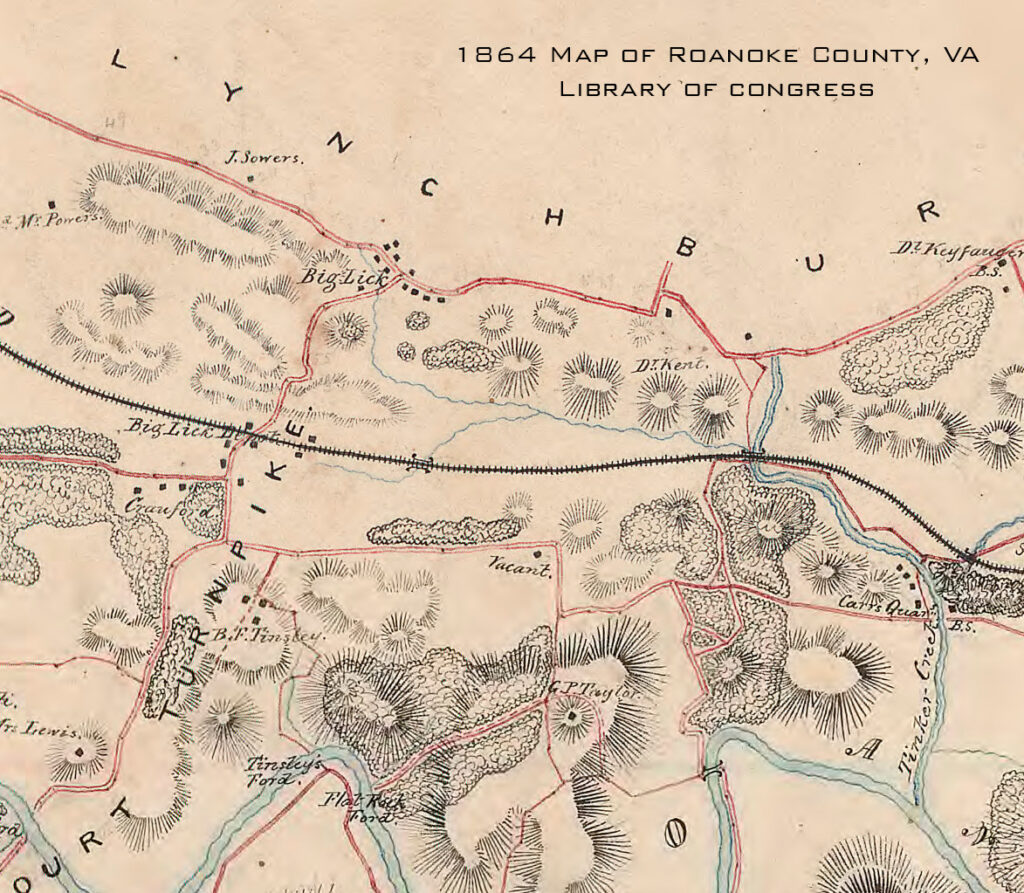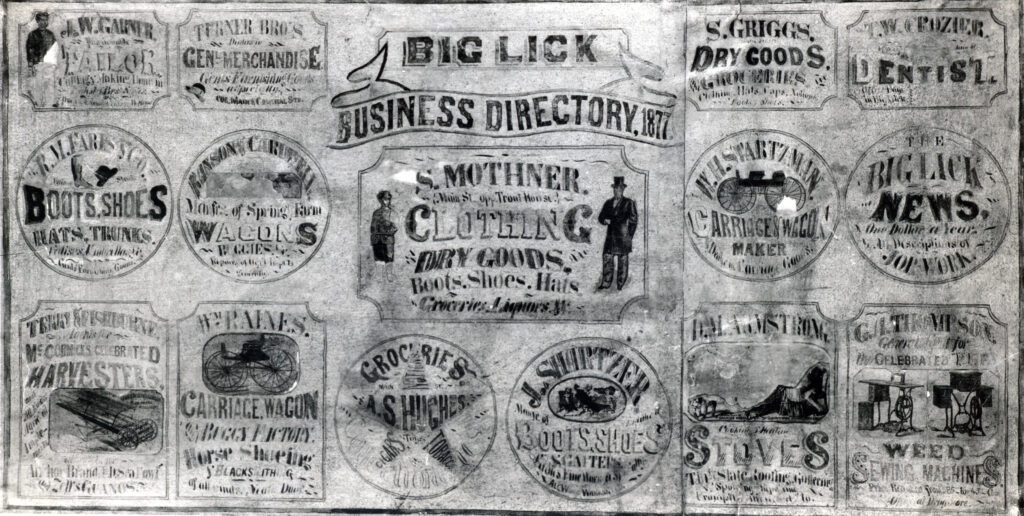Virginia & Tennessee Railroad
In 1852, the Virginia & Tennessee Railroad completed its rail line from Lynchburg to Big Lick following the lowlands near the salt licks. The railroad established a frame depot on the north side of the tracks between what is now the Henry Street Bridge and Second Street. The first train arrived on November 1, 1852.
Following the completion of the railroad, development shifted southwest toward the depot, and the settlement of Gainesborough became known as Old Lick. The old village near the lick had not prospered as expected; it was too small to qualify as the county seat, and most residents of the valley lived on farms scattered throughout the area.
Town of Big Lick
The new community of Big Lick grew around the depot. Several general merchandise stores and hotels sprung up in the area. Farmers from neighboring counties quickly moved into tobacco production and began using the Big Lick Depot as a place to sell their harvests and stock up on supplies. By the beginning of the Civil War, Big Lick contained the depot, five commercial buildings, and five dwellings; however, Union Troops destroyed the depot and several factory buildings during the war.

By 1874, the community had grown large enough to be chartered as a town with boundaries extending for one-half mile square in either direction around a brick depot operated by the Atlantic, Mississippi & Ohio Railroad. John Trout was appointed the first Mayor. By 1876, Big Lick consisted of three churches, seven dry goods stores, a drug store, a bank, five tobacco factories, three tobacco warehouses, a flour mill, a foundry, a tinware manufacturer, a harness maker, a wagon and plow factory, two blacksmith shops, two photograph galleries, and three saloons (mostly south of the railroad tracks near Commerce Street). In 1880, the first census reported 335 Black and mulatto residents and 334 white residents in Big Lick.

Shenandoah Valley Railroad
With the continued expansion of rail lines in the region, leaders in Big Lick saw an opportunity for continued economic prosperity. Enoch W. Clark & Company, a Philadelphia banking house, took ownership of the Atlantic, Mississippi & Ohio Railroad in 1881 and changed its name to the Norfolk & Western Railroad. Another of the Clark Company’s holdings, the Shenandoah Valley Railroad, was completed to Waynesboro, about 100 miles northeast of Big Lick. Executives planned to extend and join these rail lines to serve the Pocahontas coal deposits in West Virginia.
Historic Late Night Ride to Secure a Railroad
In April 1881, Mr. John C. Moomaw, a farmer in Coverdale, cannery owner, and a right-of-way purchasing agent for the new line of the Shenandoah Valley Railroad, saw great potential for a railroad terminus at Big Lick. At a town meeting about two dozen citizens agreed to draw up a petition inviting the Shenandoah Railroad to survey and build its new line into Big Lick. The petition included incentives for a terminal and cash offers to help acquire right-of-way. The petition and proposal was delivered hurriedly via a late night horse ride by Mr. Charles W. Thomas, who met Mr. Moomaw near Buchanan on “a road skirting the creek” just before one o’clock am. The proposal was delivered just in time for a meeting with directors of the Shenandoah Valley Railroad in Lexington later that day.
In May 1881, the Shenandoah Valley Railroad (SVR) announced that Big Lick would become the southern terminus of its line. While the two railroads remained separate corporations, Frederick Kimball was president of the SVR and vice-president of the N&W, and there was member overlap on the two boards of directors. With the new rail connection, Big Lick became the headquarters for the N & W Railroad. Its officials selected locations for the tracks, depot, office building, and hotel. Additionally, Clark & Company established the Roanoke Machine Works, which manufactured and repaired locomotives and rail cars, on a site to the east. Clark & Company also established a subsidiary company in order to provide offices and housing for the growing railroad work force.
In July 1881, the Roanoke Land & Improvement Company was organized to acquire land, lay out streets, erect houses, and build and equip a hotel at the junction of the N&W and SVR railroads. Frederick Kimball, president of the N&W, also served as a charter member of the Roanoke Land & Improvement Company. With the coming of the railroads, the town of Big Lick was positioned for growth. In order to attract businesses that would take advantage of the prime location, residents of the Town of Big Lick decided to change its name to Roanoke. In the coming years, town leaders were very successful in attracting a wide range of commercial and manufacturing enterprises.
Sources
American Publishing Company. (1891). Perspective Map of the city of Roanoke, Va. Milwaukee. Library of Congress. https://lccn.loc.gov/75696650
Blanton, A. (2005). Gainsboro Historic District. National Register of Historic Places, Final Nomination. Virginia Department of Historic Resources. No. 128-5762.
Blanton, A. (2002). Roanoke Downtown District. National Register of Historic Places, Final Nomination. Virginia Department of Historic Resources. No. 128-5761
Confederate States Of America. Army. Dept. Of Northern Virginia. Chief Engineer’S Office, Campbell, A. H., Coyle, J. M., Hutchinson, W. & Izard, W. (1864). Map of Roanoke County Va.: southern section. [S.l.: Chief Engineer’s Office, D.N.V] [Map]. Library of Congress. https://www.loc.gov/item/gvhs01.vhs00371/.
Dotson, R. (2007). Roanoke, Virginia, 1882-1912: Magic City of the New South (1st ed.). University of Tennessee Press.
Jack, G. S., & Jacobs, E. B. (1912). History of Roanoke County. Stone Printing.
White, Clare.(1982). Roanoke 1740-1982. Roanoke Valley Historical Society. Hickory Printing.
Vosmick, Julie. (1995). Hotel Roanoke. National Register of Historic Places, Final Nomination.Virginia Department of Historic Resources. No. 128-0025.
